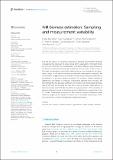Files in this item
Krill biomass estimation : sampling and measurement variability
Item metadata
| dc.contributor.author | Bairstow, Fiona | |
| dc.contributor.author | Gastauer, Sven | |
| dc.contributor.author | Wotherspoon, Simon | |
| dc.contributor.author | Brown, C. Tom A. | |
| dc.contributor.author | Kawaguchi, So | |
| dc.contributor.author | Edwards, Tom | |
| dc.contributor.author | Cox, Martin J. | |
| dc.date.accessioned | 2022-09-07T10:30:31Z | |
| dc.date.available | 2022-09-07T10:30:31Z | |
| dc.date.issued | 2022-08-22 | |
| dc.identifier | 281211014 | |
| dc.identifier | 939315b1-d71d-4793-9fdf-5c72414cbcc7 | |
| dc.identifier | 000850672500001 | |
| dc.identifier | 85137981760 | |
| dc.identifier.citation | Bairstow , F , Gastauer , S , Wotherspoon , S , Brown , C T A , Kawaguchi , S , Edwards , T & Cox , M J 2022 , ' Krill biomass estimation : sampling and measurement variability ' , Frontiers in Marine Science , vol. 9 , 903035 . https://doi.org/10.3389/fmars.2022.903035 | en |
| dc.identifier.issn | 2296-7745 | |
| dc.identifier.other | Jisc: 585455 | |
| dc.identifier.other | ORCID: /0000-0002-4405-6677/work/118799930 | |
| dc.identifier.uri | https://hdl.handle.net/10023/25960 | |
| dc.description | FB is funded by an EPSRC studentship (grant code: EP/R513337/1). | en |
| dc.description.abstract | Krill are the subject of growing commercial fisheries and therefore fisheries management is necessary to ensure long-term sustainability. Krill catch limits, set by Commission for the Conservation of Antarctic Marine Living Resources, are based on absolute krill biomass, estimated from acoustic-trawl surveys. In this work, we develop a method for determining an error budget for acoustic-trawl surveys of krill which includes sampling and measurement variability. We use our error budget method to examine the sensitivity of biomass estimates to parameters in acoustic target strength (TS) models, length frequency distribution and length to wetmass relationships derived from net data. We determined that the average coefficient of variation (CV) of estimated biomass was 17.7% and the average CV due from scaling acoustic observations to biomass density was 5.3%. We found that a large proportion of the variability of biomass estimates is due to the krill orientation distribution, a parameter in the TS model. Orientation distributions with narrow standard deviations were found to emphasise the results of nulls in the TS to length relationship, which has to potential to lead to biologically implausible results. | |
| dc.format.extent | 19 | |
| dc.format.extent | 10904296 | |
| dc.language.iso | eng | |
| dc.relation.ispartof | Frontiers in Marine Science | en |
| dc.subject | Marine Science | en |
| dc.subject | Antarctic krill | en |
| dc.subject | Biomass | en |
| dc.subject | Fisheries acoustics | en |
| dc.subject | Geostatistics | en |
| dc.subject | Target strength | en |
| dc.subject | Wetmass | en |
| dc.subject | GC Oceanography | en |
| dc.subject | DAS | en |
| dc.subject | SDG 14 - Life Below Water | en |
| dc.subject.lcc | GC | en |
| dc.title | Krill biomass estimation : sampling and measurement variability | en |
| dc.type | Journal article | en |
| dc.contributor.institution | University of St Andrews. School of Physics and Astronomy | en |
| dc.contributor.institution | University of St Andrews. Centre for Biophotonics | en |
| dc.contributor.institution | University of St Andrews. Office of the Principal | en |
| dc.identifier.doi | 10.3389/fmars.2022.903035 | |
| dc.description.status | Peer reviewed | en |
This item appears in the following Collection(s)
Items in the St Andrews Research Repository are protected by copyright, with all rights reserved, unless otherwise indicated.

